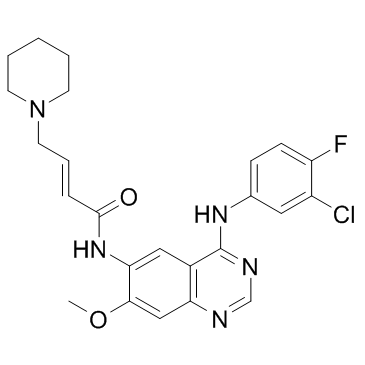
Dacomitinib
CAS No. 1110813-31-4
Dacomitinib( PF-00299804 | PF-299804 | PF 299804 | PF 00299804 )
Catalog No. M10413 CAS No. 1110813-31-4
Dacomitinib (PF-00299804, PF-299804) is a potent, irreversible, orally active pan-ErbB receptor tyrosine kinase inhibitor with IC50 of 6, 45.7 and 73.7 for EGFR, ERBB2 and ERBB4, respectively.
Purity : >98% (HPLC)
 COA
COA
 Datasheet
Datasheet
 HNMR
HNMR
 HPLC
HPLC
 MSDS
MSDS
 Handing Instructions
Handing Instructions
| Size | Price / USD | Stock | Quantity |
| 2MG | 41 | In Stock |


|
| 5MG | 65 | In Stock |


|
| 10MG | 116 | In Stock |


|
| 25MG | 170 | In Stock |


|
| 50MG | 227 | In Stock |


|
| 100MG | 340 | In Stock |


|
| 200MG | 421 | In Stock |


|
| 500MG | 692 | In Stock |


|
| 1G | Get Quote | In Stock |


|
Biological Information
-
Product NameDacomitinib
-
NoteResearch use only, not for human use.
-
Brief DescriptionDacomitinib (PF-00299804, PF-299804) is a potent, irreversible, orally active pan-ErbB receptor tyrosine kinase inhibitor with IC50 of 6, 45.7 and 73.7 for EGFR, ERBB2 and ERBB4, respectively.
-
DescriptionDacomitinib (PF-00299804, PF-299804) is a potent, irreversible, orally active pan-ErbB receptor tyrosine kinase inhibitor with IC50 of 6, 45.7 and 73.7 for EGFR, ERBB2 and ERBB4, respectively; irreversibly inhibits erbB tyrosine kinase activity through binding at the ATP site and covalent modification of nucleophilic cysteine residues in the catalytic domains of erbB family members inhibits erbB1 autophosphorylation in the A431 human squamous cell carcinoma line with IC50 of 15.1 nM; causes significant antitumor activity, including marked tumor regressions in a variety of human tumor xenograft models that express and/or overexpress erbB family members or contain the double mutation (L858R/T790M) in EGFR associated with resistance to gefitinib and erlotinib.Lung Cancer Phase 3 Clinical(In Vitro):Dacomitinib (PF00299804) effectively inhibits the in vitro kinase activity of wild-type EGFR (IC50=6 nM)with similar efficacy. Dacomitinib also effectively inhibits wild-type ERBB2 with IC50 of 45.7 nM. In H441, an IC50 is reached with Dacomitinib but only at a very high concentration (4 μM) and likely reflects off-target effects. In cell lines wild-type for both EGFR and K-ras (H322, H1819, and Calu-3), ZD1839 and Dacomitinib both effectively inhibit growth of H1819 and Calu-3 cells but not of H322 cells. Dacomitinib is a pan-ERBB inhibitor and most EGFR mutant cell lines express multiple ERBB family members, the effects on EGFR phosphorylation could potentially be indirect. Dacomitinib inhibits EGFR phosphorylation in all of the different EGFR T790M proteins whereas ZD1839 is ineffective even at 10 μM. In the NIH3T3 cells, phosphorylation of EGFR L858R/T790M is completely inhibited by 1 nM Dacomitinib, whereas 100 nM or greater is required to inhibit EGFR WT/T790M or Del/T790M. The HER2-amplified cell lines are most sensitive to growth inhibition by Dacomitinib (IC50<1 μM in 14 of 16 lines; 87.5%) as compared with 5 of 28 (17.9%) of HER2-nonamplified lines (excluding immortalized lines).(In Vivo):To evaluate the efficacy of Dacomitinib, xenografts in nu/nu mice are generated using HCC827 GFP and HCC827 Del/T790M cells and treated the mice with Dacomitinib. Dacomitinib (10 mg/kg/d by daily oral gavage) effectively inhibits the growth of HCC827 GFP xenografts. In contrast, HCC827 Del/T790M xenografts are resistant to ZD1839, whereas Dacomitinib treatment is substantially more effective at inhibiting growth of this xenograft model.
-
In VitroDacomitinib (PF00299804) effectively inhibits the in vitro kinase activity of wild-type EGFR (IC50=6 nM)with similar efficacy. Dacomitinib also effectively inhibits wild-type ERBB2 with IC50 of 45.7 nM. In H441, an IC50 is reached with Dacomitinib but only at a very high concentration (4 μM) and likely reflects off-target effects. In cell lines wild-type for both EGFR and K-ras (H322, H1819, and Calu-3), ZD1839 and Dacomitinib both effectively inhibit growth of H1819 and Calu-3 cells but not of H322 cells. Dacomitinib is a pan-ERBB inhibitor and most EGFR mutant cell lines express multiple ERBB family members, the effects on EGFR phosphorylation could potentially be indirect. Dacomitinib inhibits EGFR phosphorylation in all of the different EGFR T790M proteins whereas ZD1839 is ineffective even at 10 μM. In the NIH3T3 cells, phosphorylation of EGFR L858R/T790M is completely inhibited by 1 nM Dacomitinib, whereas 100 nM or greater is required to inhibit EGFR WT/T790M or Del/T790M. The HER2-amplified cell lines are most sensitive to growth inhibition by Dacomitinib (IC50<1 μM in 14 of 16 lines; 87.5%) as compared with 5 of 28 (17.9%) of HER2-nonamplified lines (excluding immortalized lines).
-
In VivoTo evaluate the efficacy of Dacomitinib, xenografts in nu/nu mice are generated using HCC827 GFP and HCC827 Del/T790M cells and treated the mice with Dacomitinib. Dacomitinib (10 mg/kg/d by daily oral gavage) effectively inhibits the growth of HCC827 GFP xenografts. In contrast, HCC827 Del/T790M xenografts are resistant to ZD1839, whereas Dacomitinib treatment is substantially more effective at inhibiting growth of this xenograft model.
-
SynonymsPF-00299804 | PF-299804 | PF 299804 | PF 00299804
-
PathwayAngiogenesis
-
TargetEGFR
-
RecptorEGFR|HER2/ErbB2
-
Research AreaCancer
-
IndicationLung Cancer
Chemical Information
-
CAS Number1110813-31-4
-
Formula Weight469.9
-
Molecular FormulaC24H25ClFN5O2
-
Purity>98% (HPLC)
-
SolubilityDMSO: ≥ 50 mg/mL (Need ultrasonic)
-
SMILESCOC1=C(C=C2C(=C1)N=CN=C2NC3=CC(=C(C=C3)F)Cl)NC(=O)/C=C/CN4CCCCC4
-
Chemical Name2-Butenamide, N-[4-[(3-chloro-4-fluorophenyl)amino]-7-methoxy-6-quinazolinyl]-4-(1-piperidinyl)-, (2E)-
Shipping & Storage Information
-
Storage(-20℃)
-
ShippingWith Ice Pack
-
Stability≥ 2 years
Reference



-
Poziotinib hydrochlo...
Poziotinib hydrochloride irreversibly inhibits EGFR (HER1 or ErbB1), including EGFR mutants, HER2, and HER4, thereby inhibiting the proliferation of tumor cells that overexpress these receptors.?It is an orally bioavailable, quinazoline-based pan epidermal growth factor receptor (EGFR or HER) inhibitor with potential antineoplastic activity.?
-
Afatinib dimaleate
An irreversible, dual EGFR/HER2 inhibitor with IC50 of 0.5/0.4/10/14 nM for wt EGFR/EGFR L858R/EGFR L858R+T790M/HER2 respectively.
-
XL-647
XL-647 (Tesevatinib, EXEL-7647, KD-019) is a novel spectrum-selective kinase inhibitor that potently inhibits the EGFR, ErbB2, KDR and EphB4 with IC50 of 0.3, 16, 1.5 and 1.4 nM, respectively.



 Cart
Cart
 sales@molnova.com
sales@molnova.com


